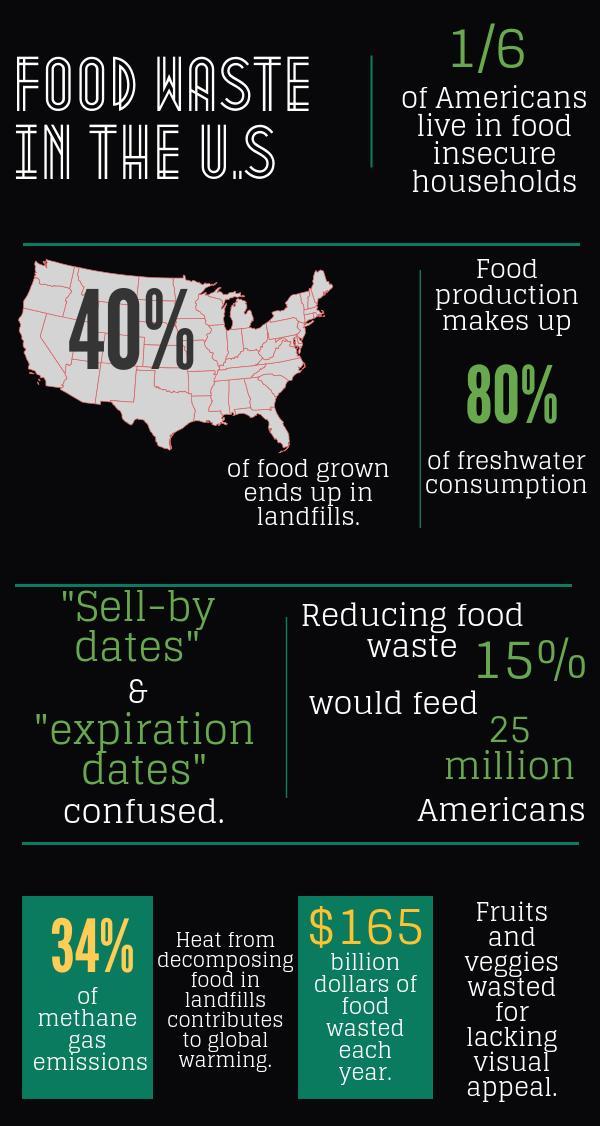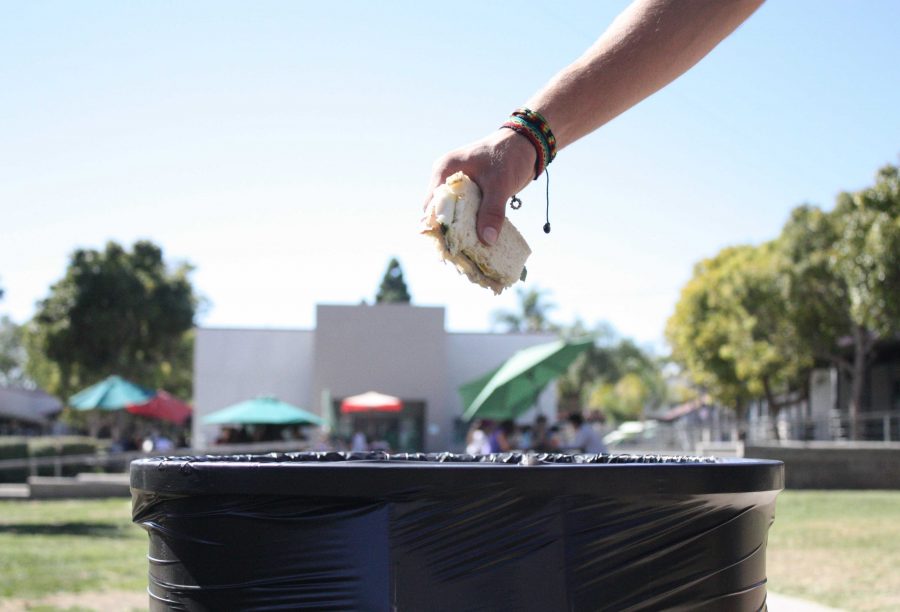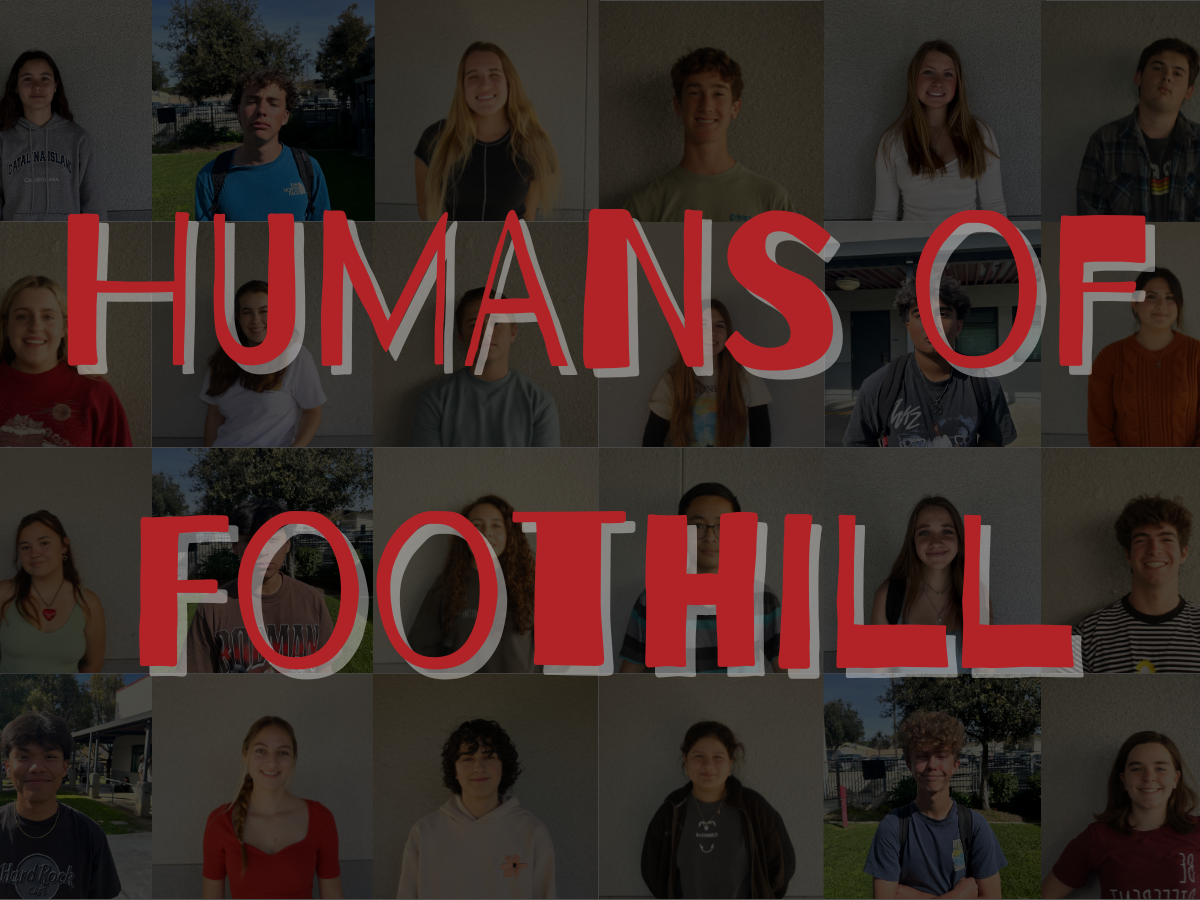When it comes to preserving food and reducing its waste, America is not the country paving the path, as $165 billion worth of food is being thrown out annually. The United States per capita food waste has increased almost 50 percent since 1974.
Multiple factors come into question when asking why Americans are so wasteful, ranging from produce not looking as aesthetically pleasing as the rest to ignorance on the accuracy of sell-by dates.

Not only is it wasteful to needlessly throw out food, it can also be costly to our environment and economy. According to the Natural Resources Defense Council, the process of getting food from the farms to our plates requires 10 percent of America’s total energy budget, makes up 80 percent of freshwater consumption in America and consumes 50 percent of America’s land. Yet, 40 percent of the food produced ends up in landfills.
The bigger picture
It is predicted that by 2025, the world population will have increased from roughly 7 billion to around 8 billion. And while the population increase will be seen most in developing countries such as Africa, it still poses an important question for all nations: “How will we feed all those people?”
Today, about one-sixth of the American population live in food-insecure households, meaning that families have to decide between buying food or other basic necessities. And yet, despite this deficit, the nation is still faced with the problem of overproduction of food, a large majority of which will be thrown out.
“There are families out there who are scrambling for food and yet there are families throwing whole bags of lettuce and fresh vegetables and fruits out,” senior Katherine Holmes said.
However, it’s not just food that is being wasted when it is thrown out. The oil lost in production of food that ends up in a landfill is 70 times greater than the amount lost in the Deepwater Horizon disaster of 2010.
It is estimated that reducing food waste by 15 percent would feed roughly 25 million Americans, while easing the environmental impacts. But to effectively reduce waste, it is necessary to improve preservation of the food and educate people and businesses on how to best avoid wastage.
Factors
Various factors come into question when discussing why food waste has augmented so much in the last few years. One of the many reasons is that consumers are attracted to aesthetically pleasing fruits and vegetables.
When a fruit or vegetable’s appearance isn’t held up to the normal standardized conditions, consumers often ostracize it because they believe there is something wrong with it.
“We have an industrialized food system where the fruits and vegetables that we grow have to be a certain shape and size in order to be what’s considered marketable,” Farm Educator for the Abundant Table Erynn Smith said. “A lot of perfectly good fruits and vegetables unfortunately waste in the seals because they aren’t able to get a good enough price because they’re not the shape and size they’re supposed to be.”
The United States Department of Agriculture has a grading scale; if a fruit or vegetable doesn’t match the criteria, it loses two-thirds of its market value to a farmer. If it’s not seen as profitable, farmers often discard it.
[soundcloud url=”https://api.soundcloud.com/tracks/228624062″ params=”color=ff5500&auto_play=false&hide_related=false&show_comments=true&show_user=true&show_reposts=false” width=”100%” height=”166″ iframe=”true” /]
However, according to Smith, organizations such as Gleaming Programs has sprung up to pick up the leftover “imperfect” fruits and vegetables.
“Gleaners can go out to farms to have those non-marketable fruits and vegetables. They can harvest them and distribute them into food pantries where food-insecure families can get access to fruits and vegetables,” Smith said.
Smith believes that if consumers were to alter their demands of products, that that would affect what farmers are growing.
“We live in a consumer culture where consumers drive the market,” she said. “Because we are accustomed to seeing huge apples or perfectly large sized lettuces, we don’t want to choose anything that isn’t deemed quote unquote perfect.”
“That’s driving what farmers are able to grow and sell, so if we were able to change our consumer culture and educate ourselves as consumers that taste is not necessarily tied to size or shape, then we would be able to demand differently and that would affect what farmers are growing,”
Besides the beauty aspect of it, ignorance of sell-by dates is another factor contributing to the increase of food waste in landfills.

According to the Natural Resources Defense Council, nine out of 10 consumers have at one point thrown out food that has past sell-by date, fearing its safety. However, as sell-by date labels aren’t regulated by the federal government, except for baby formulas, its accuracy is not as official as one might believe.
Sell-by dates are rarely ever exact and almost none reflect the safety of its content. They’re merely suggestions from the manufacturers of when the product will be at its peak quality.
“There are actually websites dedicated that basically say that industries put the sell-by dates to buy more product,” health teacher Kurt Miller said. “The sell-by dates are so short and that’s to increase the amount of products they’re buying. […] Now, of course there are a lot of food that you certainly need to be more careful of like dairy and meats.”
Lastly, one of the bigger contributors to food waste is simply the fact that businesses and markets throw away leftover food when stores close rather than donating them to homeless shelters.
This is largely due to the mistaken belief that if a store was to donate food to a homeless shelter and someone from the shelter becomes ill due to the product, that the said person would sue the store in retaliation.
However, under the Bill Emerson Good Samaritan Food Donation Act, a person cannot be legally sued if he or she donates products under good intentions.
“Even though that might be a reality, I think the issue is that people still have the perception that they’ll be liable in case they donate food. It’s more of a psychological issue than a legal issue,” Miller said.
Consequences of food waste
Due to the increase of food waste in landfills, a number of long-term consequences appear. One of the more dangerous ones is the release of methane gas.
Food lying beneath piles of waste are kept in anaerobic states for lengthy periods of time and decompose without air. As a result, that airless setting releases methane, a greenhouse gas that traps heat.
Methane gas is dangerous in that if it is released into the atmosphere before being used; it absorbs the sun’s heat and warms the Earth. This can have devastating impacts on our climate as it is extremely effective in absorbing and trapping heat.
According to End Hunger, landfills are the greatest providers of methane gas that’s a human-related source. It accounts for nearly 34 percent of methane emission.
Another consequence of food waste that future generations will encounter is a shortage of water and land resources. According to the Farmland Information Center, 40.8 percent of America is covered in farmland. The agricultural sector consumes approximately 70 percent of the world’s storage of freshwater, on a global scale.
“We’re definitely going to see a depletion of resources for sure if people are going to keep throwing away food when they’re not bad or buying too much food,” Holmes said. “It’s definitely going to be detrimental to future generations because if we don’t watch what we throw away and how much we’re using our resources, then we’re really just being ignorant and not choosing to care about or respect our earth.”
Solutions
The problem with food wastage is not one that can be corrected over the course of days, months or years. The U.S Department of Agriculture and Environmental Protection Agency announced that for the first time there will be a national target for reducing food waste.
In Seattle, citizens are fined for not sorting through their trash and recyclables Massachusetts has begun to place food waste bans on schools and businesses. There is legislation that will increase tax deduction for businesses that donate surplus food, but at the moment 50 percent of the reduction will be voluntary.
The goal of the movement is not to force citizens to throw out less food, but to change the culture surrounding it. Such measures are aimed at educating the public and changing the mindset to one that is “sensitive” to food waste, while reaping the environmental and economic benefits at the same time.
[soundcloud url=”https://api.soundcloud.com/tracks/228623938″ params=”color=ff5500&auto_play=false&hide_related=false&show_comments=true&show_user=true&show_reposts=false” width=”100%” height=”166″ iframe=”true” /]
Many stores are making the decision to sell produce that is perfectly fine in quality, but not quite as visually appealing. However, the rules regarding food safety are not as clear as they could be.
Holmes thinks that Americans will also need to learn the difference between sell-by dates (the suggested date for peak freshness) and expiration dates (the date past which foods are no longer safe to eat).
“Learning the difference between an expiration date and a sell-by date is definitely important because some people will see the sell-by date and deem it unacceptable to eat after it has past its sell-by date,” Holmes said.
Compost is also one of the ways people can reduce food waste domestically. Composting is naturally recycling decomposed organic products into soil.
“If you are going to throw gross vegetables and fruits with mold on them out, then compost them. Don’t throw them away,” Holmes said.
Identifying which foods are wasted most often and why, in both businesses and at home, is key to keep food from piling up in landfills.
“If you saw what a massive landfill looked like and if you saw all of the environmental and social impacts of landfills, you might be less likely to choose things that actually end up filling up our landfills. I think we all need to be responsible for recognizing and understanding the impacts of our choices,” Smith said.
Featured Photo Credit: Carrie Coonan/The Foothill Dragon Press









Sabrena Rodriguez • Nov 15, 2015 at 3:14 pm
Great article about a very important issue! It’s a complicated issue that will require many different approaches to resolve. Especially in California, where we are fortunate to have year-round production, we take for granted fresh, inexpensive food.
There was a great story on NPR about a Basque town’s efforts to share food surplus: http://www.npr.org/sections/thesalt/2015/08/13/431960054/to-cut-food-waste-spains-solidarity-fridge-supplies-endless-leftovers